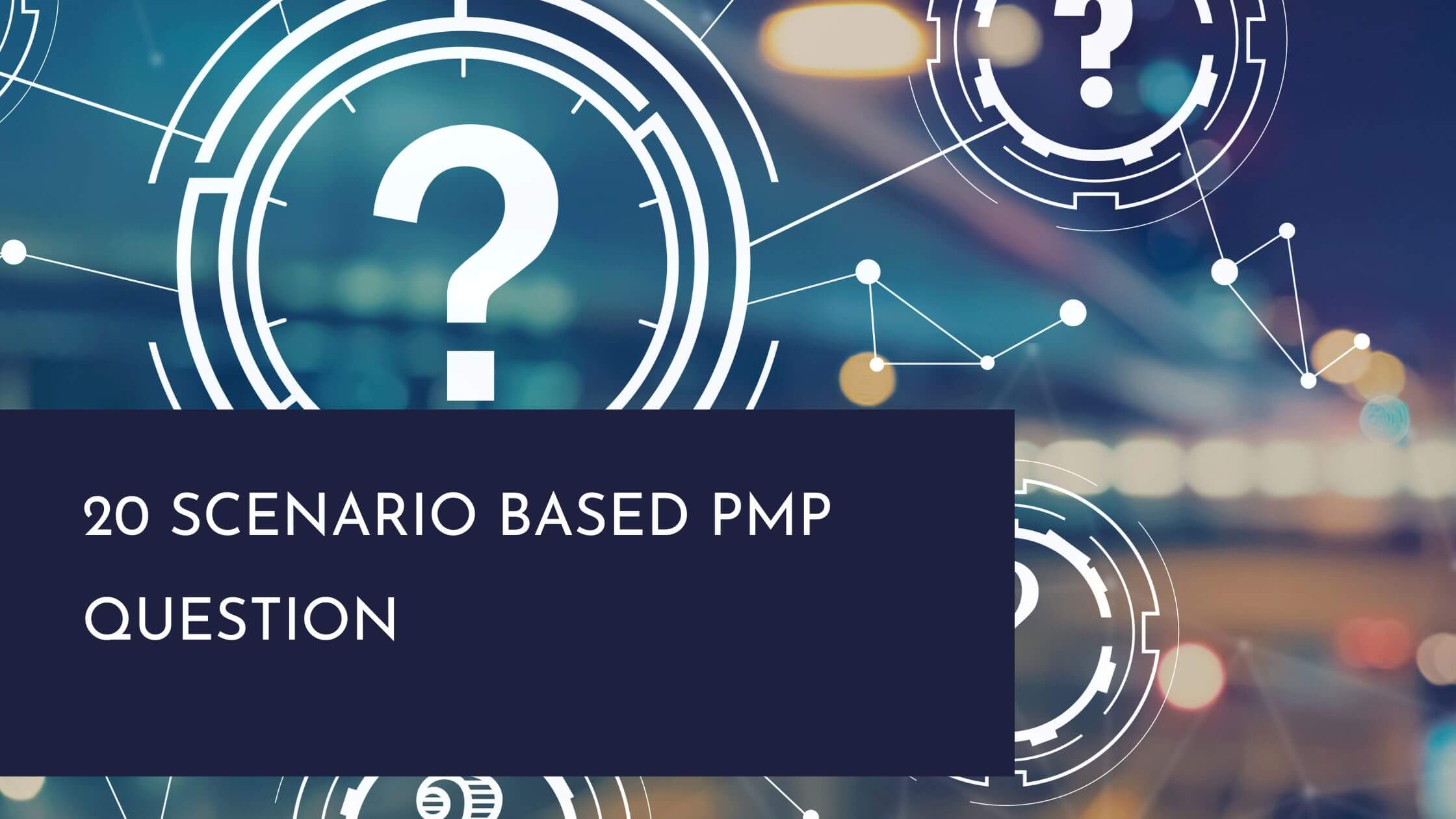20 Scenario Based pmp question

In the field of project management, professionals are required to navigate various scenarios and make critical decisions to ensure project success. To assess their knowledge and ability to handle real-life situations, the Project Management Professional (PMP) certification exam often includes scenario-based questions. These questions present hypothetical scenarios that test a candidate’s understanding of project management principles, processes, and best practices. In this compilation of 20 scenario-based PMP question and answers, we explore a range of project management challenges and provide insights into how to approach and resolve them effectively.
Scenario 1: You’re managing a software development project, and a critical task is running behind schedule. The team suggests adding more resources to speed up the completion. What should you do?
Answer: Evaluate the impact of adding more resources on the project schedule, cost, and quality. Consider the risks associated with changing the team dynamics and ensure that the addition of resources will expedite the task without compromising quality. Additionally, review the project’s resource allocation and availability before making a decision.
Scenario 2: During project execution, a key stakeholder requests a scope change that will significantly impact the project timeline. What should you do?
Answer: Initiate the change control process and evaluate the impact of the requested scope change on the project’s triple constraints: scope, schedule, and cost. Assess the risks associated with the change and consider alternatives or compromises to accommodate the stakeholder’s request without jeopardizing the project objectives. Communicate the potential impacts to the stakeholder and obtain their approval before proceeding.
Scenario 3: You’re managing a construction project, and the weather conditions are affecting the progress. What should you do?
Answer: Refer to the project management plan and assess the contingency plans for adverse weather conditions. Evaluate the impact on the project schedule and consider implementing alternative work methods or rescheduling activities to mitigate the delays caused by weather conditions. Communicate with the project team and stakeholders about the situation and any necessary adjustments to the project plan.
Scenario 4: A team member consistently fails to meet their assigned tasks’ deadlines, affecting the project’s progress. How should you handle this situation?
Answer: Address the issue promptly by discussing the problem with the team member. Understand any underlying causes for the missed deadlines and offer support or additional resources if needed. If the issue persists, consider taking corrective actions, such as reassigning tasks, providing additional training, or initiating a performance improvement plan. Document the performance issues and maintain open communication with the team member throughout the process.
Scenario 5: Your project is facing unexpected risks that were not identified during the planning phase. What steps should you take to manage these risks effectively?
Answer: Initiate a risk assessment process to identify and evaluate the newly emerged risks. Analyze the impact and probability of each risk and prioritize them based on their severity. Develop risk response strategies, such as mitigating, transferring, accepting, or avoiding the risks. Implement the appropriate risk response actions and continuously monitor and review the risk register throughout the project to identify any new risks that may arise.
Scenario 6: A key vendor for your project encounters financial difficulties, and there is a possibility they might not deliver as planned. How should you mitigate this risk?
Answer: Assess the potential impact on the project’s schedule, cost, and quality due to the vendor’s financial difficulties. Engage in open communication with the vendor to understand their situation and explore potential alternatives or backup plans. Develop contingency plans, such as identifying backup vendors or renegotiating the contract terms, to mitigate the risk of non-delivery. Monitor the vendor’s financial situation closely and adapt the project plan accordingly to minimize the impact on project outcomes.
Scenario 7: You’re managing a project with a diverse team that includes members from different cultures and backgrounds. Communication issues have started to arise due to cultural differences. How should you address this?
Answer: Recognize and embrace the cultural diversity within the team. Foster an inclusive and respectful team environment where everyone feels comfortable expressing their perspectives. Encourage open and transparent communication, and promote active listening among team members. Provide cross-cultural training and communication workshops to enhance understanding and awareness of cultural differences. Establish clear communication channels and protocols to address any language or cultural barriers that may arise during the project.
Scenario 8: A critical stakeholder expresses dissatisfaction with the project deliverables during a project review meeting. How should you handle this situation?
Answer: Listen attentively to the stakeholder’s concerns and clarify their expectations for the project deliverables. Assess the validity of their feedback and determine if adjustments or improvements are necessary. Communicate openly with the stakeholder, acknowledging their concerns and discussing potential solutions. If needed, initiate a change request or update the project plan to address the stakeholder’s feedback. Strive to maintain a positive relationship with the stakeholder by demonstrating your commitment to addressing their concerns and delivering successful project outcomes.
Scenario 9: Your project is facing resource constraints, and team members are feeling overwhelmed with their workloads. How can you manage this situation effectively?
Answer: Evaluate the project’s resource utilization and workload distribution. Identify tasks that can be delegated, streamlined, or postponed to alleviate the workload pressure. Communicate with team members to understand their concerns and identify potential solutions collaboratively. Consider bringing in additional resources, if feasible, to support the team and balance the workload. Prioritize tasks and set realistic expectations to ensure a manageable workload. Provide support, guidance, and motivation to the team members to maintain their morale and productivity.
Scenario 10: During project execution, you identify a deviation from the original project plan that could impact the project’s success. What steps should you take to address this deviation?
Answer: Document the deviation and evaluate its impact on the project’s objectives, scope, schedule, and budget. Identify the root causes of the deviation and assess the potential risks associated with it. Engage the project team and stakeholders in a discussion to analyze the situation and propose corrective actions. Develop a revised plan that addresses the deviation and its impacts, ensuring alignment with project goals. Implement the approved corrective actions and communicate the revised plan to all relevant parties.
Scenario 11: Your project involves collaborating with external contractors, but one of the contractors consistently delivers subpar work. How should you handle this situation?
Answer: Assess the performance of the contractor objectively, considering the quality of their work, adherence to project requirements, and timeliness of deliverables. Communicate your concerns to the contractor and provide specific feedback regarding the deficiencies in their performance. If the contractor fails to improve, consult the contract terms and review the available options, such as enforcing penalties, terminating the contract, or seeking alternative contractors. Document all interactions and maintain open communication to minimize disruptions to the project.
Scenario 12: Your project requires obtaining necessary permits and approvals from regulatory authorities, but the process is taking longer than anticipated. How can you manage this delay effectively?
Answer: Review the project schedule and assess the impact of the permit approval delay on the overall project timeline. Communicate with the regulatory authorities to gain clarity on the status and reasons for the delay. Consider alternative strategies, such as parallel processing or resequencing activities, to mitigate the impact of the delay on the critical path. Keep stakeholders informed about the situation and manage their expectations accordingly. Continuously monitor the progress of permit approvals and update the project plan as necessary to reflect the changes.
Scenario 13: During the execution phase of your project, you discover that a key deliverable does not meet the required quality standards. What steps should you take to address this issue?
Answer: Document the quality issue and conduct a thorough analysis to identify the root cause of the problem. Engage the relevant stakeholders, including the quality control team, to assess the impact of the issue on the project objectives. Develop a corrective action plan that outlines steps to address the quality deficiency and bring the deliverable up to the required standards. Implement the necessary actions, such as rework or quality assurance activities, and conduct additional inspections to verify the desired level of quality has been achieved.
Scenario 14: You’re managing a project with a geographically dispersed team, and communication barriers arise due to different time zones and cultural norms. How can you effectively manage communication in this situation?
Answer: Establish clear communication protocols that take into account the time zones and cultural differences within the team. Schedule regular meetings or check-ins to accommodate the availability of team members from different regions. Utilize technology tools, such as video conferencing or project management software, to facilitate real-time collaboration and information sharing. Foster a culture of open communication and encourage team members to express their concerns or ideas openly. Provide guidelines or training on cross-cultural communication to enhance understanding and minimize misunderstandings.
Scenario 15: Your project is facing unforeseen budget constraints, and it becomes challenging to fund all planned activities. How should you manage the budget constraints effectively?
Answer: Review the project budget and identify areas where costs can be reduced or optimized without compromising project objectives. Prioritize project activities based on their importance and value to the project outcomes. Engage stakeholders to discuss the budget constraints and explore potential alternatives or trade-offs. Consider reevaluating the scope and making adjustments, if necessary, to align with the available budget. Monitor and track project costs closely to ensure compliance with the revised budget and implement effective cost-control measures.
Scenario 16: You’re managing a project with multiple dependencies on external suppliers. One of the suppliers encounters a production delay, impacting your project’s schedule. How should you mitigate this situation?
Answer: Communicate with the affected supplier to understand the cause of the production delay and assess the extent of the impact on your project’s schedule. Evaluate alternative options, such as sourcing from a different supplier or adjusting the project schedule to accommodate the delay. Engage in active risk management by implementing contingency plans, such as having backup suppliers or exploring expedited shipping options. Maintain open communication with stakeholders to manage their expectations and provide regular updates on the situation.
Scenario 17: Your project team is experiencing conflicts and disagreements that are affecting their productivity and collaboration. How can you address and resolve these conflicts effectively?
Answer: Acknowledge the conflicts and create a safe environment for open dialogue among team members. Encourage active listening and ensure that all perspectives are heard and respected. Identify the underlying causes of the conflicts and facilitate discussions to find common ground or compromise. Consider involving a neutral third party, such as a mediator, if necessary. Develop and implement conflict resolution strategies, such as negotiation, collaboration, or escalation, depending on the severity of the conflicts. Foster a culture of collaboration and teamwork to prevent future conflicts.
Scenario 18: Your project is nearing completion, and you need to ensure a smooth transition of the deliverables to the project’s operational phase. How should you manage this transition effectively?
Answer: Collaborate with stakeholders from the operational phase to define the transition requirements and expectations. Develop a transition plan that outlines the steps, resources, and responsibilities involved in handing over the deliverables. Conduct training or knowledge transfer sessions to equip the operational team with the necessary skills and information to take over the project’s outcomes. Establish a communication plan to ensure continuous coordination and support during the transition phase. Conduct a thorough handover and document the process to facilitate future reference and troubleshooting.
Scenario 19: Your project is facing unforeseen risks that could potentially impact its success. How can you effectively manage these risks?
Answer: Identify and analyze the newly emerged risks using risk management techniques such as brainstorming, risk assessment, and impact analysis. Prioritize the risks based on their severity and likelihood of occurrence. Develop appropriate risk response strategies, such as mitigation, acceptance, transfer, or avoidance, to address the identified risks. Implement the selected risk response actions and continuously monitor and review the risk register to identify any new risks that may arise during the project. Regularly communicate risk status and mitigation measures to stakeholders.
Scenario 20: You’re managing a project that involves multiple stakeholders with conflicting interests and priorities. How can you effectively manage these stakeholder conflicts?
Answer: Identify and engage with all key stakeholders to understand their needs, interests, and concerns. Foster open and transparent communication channels to encourage stakeholder engagement. Conduct regular stakeholder meetings or workshops to address conflicts and facilitate dialogue among stakeholders. Seek to find common ground and areas of compromise, and strive for win-win solutions when possible. Use negotiation and consensus-building techniques to resolve conflicts and reach agreements. Document agreed-upon decisions and communicate them clearly to all stakeholders involved.
Conclusion
The scenario-based PMP question covered in this compilation has provided valuable insights into the challenges that project managers may encounter during different project phases. From schedule delays and stakeholder conflicts to resource constraints and quality issues, these scenarios have tested our understanding of project management principles, communication, risk management, and stakeholder engagement. By analyzing these scenarios and their corresponding answers, we have gained valuable insights into the decision-making process and best practices in project management. As aspiring or practicing project managers, it is crucial to continually enhance our knowledge and skills to tackle complex situations. To deliver successful project outcomes join today PMP bootcamp by Eduhubspot. The application of these principles and strategies, as demonstrated in the scenarios, can contribute to the effective management of projects in diverse environments and help project managers excel in their roles.
Author: Axiswebart team has 5+ years of experience in writing content on Project Management topics and along with different publications. Also, they are delivering good write-ups on various other projects too.





